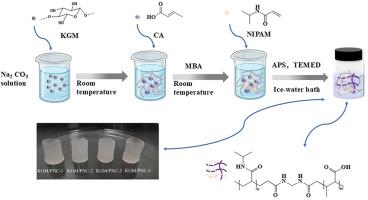Preparation and properties of konjac glucomannan/P(N-isopropylacrylamide-crotonic acid) hydrogel
IF 4.5
2区 化学
Q2 POLYMER SCIENCE
引用次数: 0
Abstract
A pH and temperature dual-responsive KGM/P(NIPAM-CA) hydrogel drug carrier was prepared by using natural polysaccharide konjac glucomannan (KGM), pH-sensitive monomer crotonic acid (CA), and temperature-sensitive monomer N-isopropylacrylamide (NIPAM). The effect of mass ratio of NIPAM to KGM on the properties of KGM/P(NIPAM-CA) hydrogels was studied by a range of testing methods. The drug loading and release properties of KGM/P(NIPAM-CA) hydrogel were investigated using 5-fluorouracil (5-FU) as a model drug. Results show that KGM/P(NIPAM-CA) exhibits good swelling and mechanical properties determined by its composition. As a drug carrier KGM/P(NIPAM-CA) hydrogel demonstrated a maximum encapsulation efficiency of 30.17% and a maximum drug loading capacity of 54.41% for 5-FU at 25°C. In simulated colonic fluid (SCF) at 25°C, the cumulative drug release rate of KGM/P(NIPAM-CA) reached 58.86% within 48 hours, which was 1.8 times higher than that in simulated gastric fluid (SGF). Furthermore, the hydrogel demonstrated biocompatibility, with a hemolysis rate of less than 3% and a cell viability exceeding 90%. These results establish KGM/P(NIPAM-CA) as a promising, biocompatible platform for stimuli-responsive, colon-targeted drug delivery.

魔芋葡甘露聚糖/P(n -异丙基丙烯酰胺-巴豆酸)水凝胶的制备及性能研究
以天然多糖魔芋葡甘露聚糖(KGM)、pH敏感单体巴豆酸(CA)和温度敏感单体n -异丙基丙烯酰胺(NIPAM)为原料,制备了pH和温度双响应的KGM/P(NIPAM)水凝胶药物载体。通过一系列测试方法研究了NIPAM与KGM的质量比对KGM/P(NIPAM- ca)水凝胶性能的影响。以5-氟尿嘧啶(5-FU)为模型药物,研究了KGM/P(NIPAM-CA)水凝胶的载药和释药性能。结果表明:KGM/P(NIPAM-CA)具有良好的溶胀性能和由其组成决定的力学性能。作为药物载体,KGM/P(NIPAM-CA)水凝胶在25℃条件下的包封效率最高为30.17%,5-FU的最大载药量为54.41%。在25℃的模拟结肠液(SCF)中,KGM/P(NIPAM-CA)在48 h内的累积药物释放率达到58.86%,是模拟胃液(SGF)的1.8倍。此外,水凝胶表现出生物相容性,溶血率小于3%,细胞存活率超过90%。这些结果表明KGM/P(NIPAM-CA)是一种有前景的、生物相容性的刺激反应性、结肠靶向药物递送平台。
本文章由计算机程序翻译,如有差异,请以英文原文为准。
求助全文
约1分钟内获得全文
求助全文
来源期刊

Polymer
化学-高分子科学
CiteScore
7.90
自引率
8.70%
发文量
959
审稿时长
32 days
期刊介绍:
Polymer is an interdisciplinary journal dedicated to publishing innovative and significant advances in Polymer Physics, Chemistry and Technology. We welcome submissions on polymer hybrids, nanocomposites, characterisation and self-assembly. Polymer also publishes work on the technological application of polymers in energy and optoelectronics.
The main scope is covered but not limited to the following core areas:
Polymer Materials
Nanocomposites and hybrid nanomaterials
Polymer blends, films, fibres, networks and porous materials
Physical Characterization
Characterisation, modelling and simulation* of molecular and materials properties in bulk, solution, and thin films
Polymer Engineering
Advanced multiscale processing methods
Polymer Synthesis, Modification and Self-assembly
Including designer polymer architectures, mechanisms and kinetics, and supramolecular polymerization
Technological Applications
Polymers for energy generation and storage
Polymer membranes for separation technology
Polymers for opto- and microelectronics.
 求助内容:
求助内容: 应助结果提醒方式:
应助结果提醒方式:


